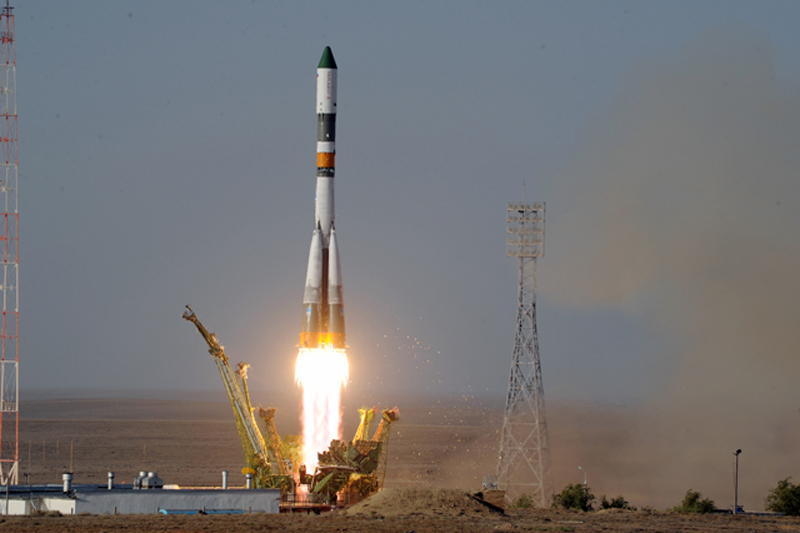
The outcome of an unmanned Russian supply spaceship launch to the International Space Station on Sunday (Oct. 30) will determine whether the station remains fully staffed in the upcoming months.
The Progress 45 cargo vessel is slated to blast off from Kazakhstan at 6:11 a.m. EDT (1011 GMT) Sunday. If anything goes wrong with the flight, the launch of three new station crewmembers — currently scheduled for Nov. 14 — would likely be delayed, because both missions use similar Russian Soyuz rockets.
And if the manned mission is delayed by more than five days or so, the station could be left without a crew for the first time in more than a decade, because the three spaceflyers currently aboard are due to come home on Nov. 22.
Russian rocket crash
The immediate outlook for the space station is unclear in the wake of the Aug. 24 crash of the Progress 44 supply vessel, which was also en route to the orbiting lab. Progress 44 slammed into the Siberian dirt after the third stage of its Soyuz rocket failed. [Photos: Russia's Lost Cargo Ship Progress 44]
"The Soyuz FG booster used to launch the Soyuz TMA crew vehicles is a variant of the Soyuz U which experienced the failure," Thomas Stafford, chairman of NASA's International Space Station Advisory Committee, wrote in testimony to the House of Representatives' Committee on Science, Space and Technology earlier this month.
As a result, the manned Soyuz mission to the orbiting lab originally scheduled for Sept. 21 was pushed back considerably, to the middle of November.
Get the Space.com Newsletter
Breaking space news, the latest updates on rocket launches, skywatching events and more!
"Its launch resumption will be dependent on the successful Soyuz U launch of Progress 45P on October 30th," Stafford added.
Stafford said he had every confidence that the Progress 45 launch would go smoothly. The Russians appear to have identified the problem that doomed Progress 44 and have instituted quality-control measures that should prevent it from happening again, other NASA officials have said.
An unmanned space station?
The space station has been continously staffed since November 2000. Bill Gerstenmaier, associate administrator for NASA's human exploration and operations directorate, told the same House committee that the chances of this streak being broken in mid-November are remote.
But if it does happen, the orbiting lab would probably not fall out of the sky while waiting for astronauts to arrive once again. NASA officials have said that the station can be operated efficiently from the ground for a while.
"The ability to get to higher orbit and to get an extended period of operation — even in an unmanned status if necessary — for one year to as much as two years is noted with some good comfort," Joseph Dyer, chairman of NASA's Aerospace Safety Advisory Panel, told the House committee.
NASA and its international partners would, of course, prefer to keep the station manned continuously, and at its full capacity of six spaceflyers if possible.
Crewmembers perform maintenance work and can troubleshoot problems that may crop up. And more scientific experiments can get done with more spaceflyers onboard — a key priority now that assembly of the station is done and it's coming into its own as a research facility, NASA officials have said.
You can follow SPACE.com senior writer Mike Wall on Twitter: @michaeldwall. Follow SPACE.com for the latest in space science and exploration news on Twitter @Spacedotcom and on Facebook.
Join our Space Forums to keep talking space on the latest missions, night sky and more! And if you have a news tip, correction or comment, let us know at: community@space.com.

Michael Wall is a Senior Space Writer with Space.com and joined the team in 2010. He primarily covers exoplanets, spaceflight and military space, but has been known to dabble in the space art beat. His book about the search for alien life, "Out There," was published on Nov. 13, 2018. Before becoming a science writer, Michael worked as a herpetologist and wildlife biologist. He has a Ph.D. in evolutionary biology from the University of Sydney, Australia, a bachelor's degree from the University of Arizona, and a graduate certificate in science writing from the University of California, Santa Cruz. To find out what his latest project is, you can follow Michael on Twitter.











